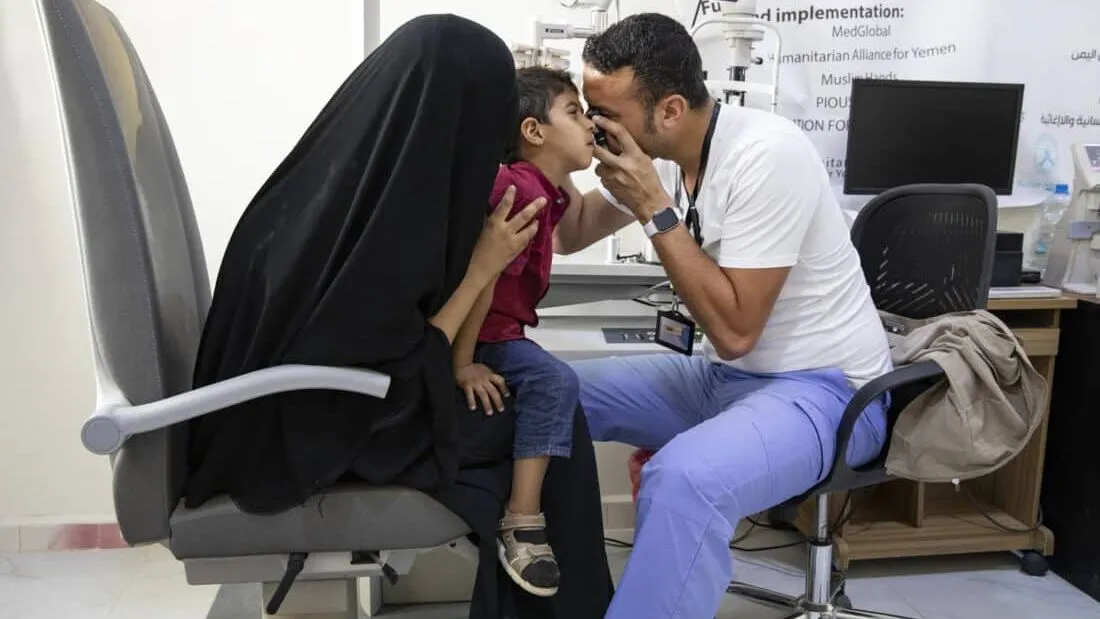6 Numbers That Underscore the Health Crisis in Yemen
After six years of war, the humanitarian crisis in Yemen is the worst on earth, with 80% of the population in need of humanitarian assistance. Here are six numbers that tell the story of the country’s massive health crisis.

Imagine if tens of thousands of doctors left Washington, D.C.
Or if everyone in Sweden and Norway lost clean water.
Or if every hospital in Maine, Vermont, New Hampshire, Connecticut, and Rhode Island was damaged by an airstrike.
That’s what life is like in Yemen right now, where war has stretched into its seventh year and 8 out of every 10 people need humanitarian assistance. Yemen is the world’s worst humanitarian crisis, and its most vulnerable populations are bearing the cost, with women and children feeling the devastating pains of war.
Project HOPE, as part of the Humanitarian Alliance for Yemen, is helping respond to the health needs of Yemenis, including those facing the threat of COVID-19. Here are six numbers that underscore the level of crisis in Yemen and the urgent need for action.

2.3 million
The number of children under 5 that will face acute malnutrition in Yemen this year.
That’s the equivalent of 31,000 school buses worth of children who are on the brink of famine right now. This number is 16% worse than last year and the highest level of acute malnutrition in Yemen since 2015.
Malnutrition causes lifelong health problems, affecting a child’s physical and cognitive development. It leads to prolonged illnesses, traps people in poverty, and exacerbates inequality.
Preventing child malnutrition starts with protecting the health of pregnant women and nursing mothers, but that is a crisis all its own in Yemen: this year, 1.2 million pregnant or breastfeeding women are also acutely malnourished — an emergency that threatens to pass on lifelong health problems to an entire generation of children.

50%
The portion of Yemen’s population that does not have access to safe water.
That would be like every single person in New York City, Los Angeles, Chicago, and Houston — the four most populous American cities — having to carry their water in jerry cans.
Yemen was already considered one of the most water-stressed countries on earth before war, but six years of conflict have devastated the country’s water infrastructure and led to a serious health emergency. Today, 18 million people lack access to safe water, while a cholera outbreak that began in 2016 has turned into a multi-year epidemic that has resulted in millions of cases and thousands of deaths.
10
The number of health care workers for every 10,000 people in Yemen — less than half the minimum set by the World Health Organization.
What would that look like in the U.S.? It would be like if 84,000 doctors and nurses left Washington, D.C., leaving just a few hundred behind.
Of Yemen’s 333 districts, 18% have no doctors at all. Many of the health care workers who have stayed behind have gone years without pay or been forced to live at their hospitals. This has had devastating consequences on the lives of millions of Yemenis during wartime, who have had to go without any sort of health care while facing the threats of conflict, famine, and disease.

70%
The percentage of births that occur at home rather than in a health care facility.
It’s not just a rural problem: according to the U.N., women in cities like Sana’a, Taiz, and Aden are having more home births due to lack of money, choosing to seek medical care only if they experience complications.
It’s a number that tells a larger story about the steep decline of women’s health in Yemen. About 12 women die every day in Yemen due to complications from pregnancy or childbirth, and 1 out of every 37 babies doesn’t make it to their second month of life. In the absence of formal health care services, community health workers have played a crucial role in providing health care to women across the country — but they also face a lack of supplies, transportation, and security.
86
The number of health care facilities that have been hit in air raids.
That’s roughly equivalent to every hospital in the state of Virginia getting hit by an airstrike. Half of Yemen’s 5,000 health facilities are not functional, and nearly 250,000 people have died since the war began.
The collapse of Yemen’s health care system has been long and excruciating, leading to what the U.N. has called “unprecedented” levels of need. But ultimately, the greatest need for Yemen’s people is peace. Until a lasting peace agreement is reached, conflict will remain the root problem beneath the massive humanitarian crisis.

16 million
The number of people in Yemen that could contract COVID-19, according to U.N. estimates.
With the collapse of the country’s health care system, there is no way to know the full reach of COVID-19 inside Yemen. But the entire country is at risk, and with so many communities lacking clean water, even basic precautions like handwashing are impossible for many.
Project HOPE is working to help prevent the spread of COVID-19 inside Yemen. As part of the Humanitarian Alliance for Yemen, we have reached more than 100,000 people in the governorates of Marib, Al Hudaydah, and Taiz with essential PPE, medical supplies, and oxygen to help strengthen the infection prevention and control measures at least eight hospitals.







